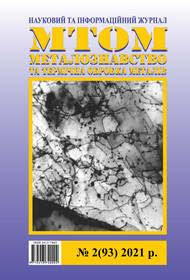Increasing the construction strength of petroleum pipes operating in agressive environment
DOI:
https://doi.org/10.30838/J.PMHTM.2413.270421.70.743Abstract
Purpose. Questions about ways to increase the structural strength of oil country tubular goods are considered. Alloying and heat treatment of medium-alloy steels should ensure: pro-carbonization to the structure of martensite and lower bainite with a minimum carbon content (C ≤ 0.3 %), high resistance to brittle fracture and hydrogen embrittlement, the formation of uniformly distributed finely dispersed carbides and sulphides of a round shape to reduce diffusion mobile hydrogen is absorbed by steel. Propose modes of thermal treatment of casing pipes that provide the required level of mechanical and operational properties. Methodology. We used standard techniques for determining the mechanical properties in tension, dynamic bending tests and fracture studies. Results. The modes of heat treatment of casing pipes of strength category E, L are proposed, which provide the required level of mechanical and operational properties and an increase in structural strength. Originality. A systematic analysis of the influence of various factors on the structural strength of oil country tubular goods operating in an aggressive environment has been carried out. The highest degree of correlation between the value of the impact toughness and the tough component in the fracture is shown. Cooling of pipes with a nozzle sprayer of the design of the Department of Heat Treatment of Metals of NMetAU, which provides high resistance to brittle fracture by increasing the proportion of the viscous component and changing the microrelief of the cup fracture. Practical value. The proposed technology of heat treatment of oil pipes, working in an aggressive environment, provides the required level of mechanical properties and resistance to hydrogen sulfide cracking.
Keywords: structural strength; oil country tubular goods; alloying; heat treatment; strength categories;
temperature and deformation parameters; hydrogen sulfide cracking; brittle fracture resistance

Downloads
Published
Issue
Section
License
Authors that are published in this journal agree to follow the conditions:
Authors reserve the right to the authorship of his work and cede the right to the journal of first publication of this work on conditions of the license under the Creative Commons Attribution License, which allows others to distribute it freely with the obligatory reference to the author of the original work and the first publication of the work in this journal.
